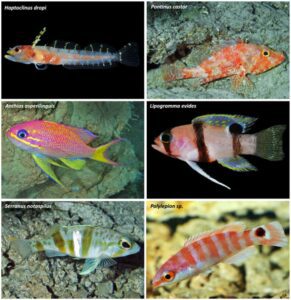 While space is considered “The Final Frontier,” there’s a massive part of the planet that needs to be explored before we make it to the finale. The ocean is so vast that humans haven’t even explored five percent of its depths, which means there are millions of species and locations we know nothing about. There’s still plenty to discover beneath the water, and scientists have found a new population in the sea.
While space is considered “The Final Frontier,” there’s a massive part of the planet that needs to be explored before we make it to the finale. The ocean is so vast that humans haven’t even explored five percent of its depths, which means there are millions of species and locations we know nothing about. There’s still plenty to discover beneath the water, and scientists have found a new population in the sea.
The newly-discovered “rariphotic zone” is located between 400-1000 feet below sea level (130-200 meters) and is considered a whole new ecosystem. While the mesophotic zone just above is well-documented as being prime coral reef real estate, this new layer is home to plenty of previously unknown fish. As of this writing, 4,500 fish were observed over 71 distinct species. Most of these fish were related to the reef fish of the layer above, who were previously thought to be unable to live below the mesophotic zone.
Furthermore, as scientists explored the reef, thirty new species of fish and invertebrates were discovered, along with six new genera. Incredibly, the area explored was a scant 0.08 square miles (0.2 square kilometers). According to marine biologist and co-author of the study on the discovery Ross Robertson, “[a]bout one in every five fish we’re finding in the rariphotic of the Caribbean is a new species.” Most of the new species are awaiting classifications and official names.

Beyond new sea creatures, the discovery of the rariphotic zone conflicts with the previous belief that the mesophotic zone was the last ecosystem before the deep sea. Instead, the rariphotic acts as a gateway between the light of the coral reefs and the dark depths of the unexplored ocean. This additional information has generated a new set of categories for the ocean, based on depth and light exposure:
- The altiphotic zone, found at 0-120 feet (0-40 meters), which receives plenty of light and is where most scuba divers visit. While widely known, it is only being given a name after the discovery of the rariphotic zone.
- The mesophotic zone, between 120-450 feet below sea level (40-150 meters), and the last place coral reefs and algal symbionts can survive. The zone receives medium sunlight.
- The rariphotic zone, which is 400-1000 feet deep (130-300 meters) and is beneath “the reef-building coral zone.” It’s as deep as a Curasub can dive and only gets a bit of sunlight.
- The deep aphotic zone, with effectively no light. It’s found 1000 feet (300 meters) and below.
Says lead and author of the study Carole Baldwin, “[While not exploring areas of the ocean thousands of miles away and deep is understandable,] tropical reefs are just below popular, highly studied shallow reefs- essentially our backyards. And tropical deep reefs are not barren landscapes on the deep ocean floor: they are highly diverse ecosystems that warrant further study. We hope that by naming the deep-reef rariphotic zone, we’ll draw attention to the need to the explore deep reefs.”
 And therein lies the true fascination with the rariphotic zone. So many new species to imagine and discover, it’s something that will engage both the scientific and creative communities. This is the beauty of nature: its ability to draw in people of all lifestyles and inspire them to do more. To discover more about the world they live in. To create versions of what could be. With each new discovery in the ocean, the mysteries of planet Earth begin to unravel. It brings humanity together, because no matter what the point of view, we all share this planet. This is, for better or for worse, our home.
And therein lies the true fascination with the rariphotic zone. So many new species to imagine and discover, it’s something that will engage both the scientific and creative communities. This is the beauty of nature: its ability to draw in people of all lifestyles and inspire them to do more. To discover more about the world they live in. To create versions of what could be. With each new discovery in the ocean, the mysteries of planet Earth begin to unravel. It brings humanity together, because no matter what the point of view, we all share this planet. This is, for better or for worse, our home.
Isn’t it about time we know more about it?







